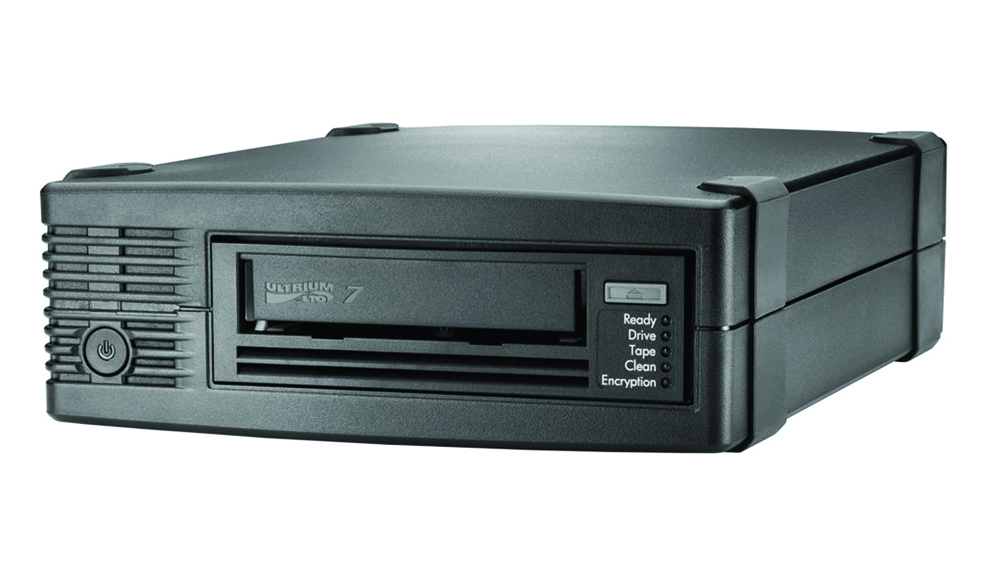HPE StoreEver LTO-7 Ultrium 15000 review
There’s plenty of life in tape backup yet. HPE’s seventh-generation LTO drive is fast and capacious


Tape backup may seem like old technology but LTO has a bright future. With the HPE StoreEver LTO-7 Ultrium 15000 ushering in a big hike in performance and capacity, this is a great time to invest.
-
+
Excellent read/write speeds; High capacity;

Linear tape open, or LTO, has become the dominant tape format for low-cost data archiving, and the seventh generation brings some significant upgrades. Native transfer rates and cartridge capacities are boosted to 300MB/sec and 6TB, while maximum hardware compression remains as LTO-6, at 2.5:1. That translates to theoretical backup speeds of 750MB/sec, and cartridge capacities that are up to a whopping 15TB in size.
LTO-7 media also sees a move from Metal Particle (MP) to Barium Ferrite (BaFe), which has superior magnetic properties essential for delivering the increased areal density for future LTO generations. The drives maintain backward compatibility with earlier media; LTO-7 units can both read and write LTO-6 MP and BaFe media, and read earlier LTO-5 MP cartridges.
HPE is the first to market with an LTO-7 backup unit, its StoreEver LTO-7 Ultrium 15000 external drive. To test it, we called on a Boston Fenway 2224-0T rack server equipped with dual 2.2GHz E5-2650 v4 Xeons, 64GB of RAM and a super-fast Intel P3500 NVMe SSD. We loaded it with Windows Server 2012 R2 and installed the A-Listed Arcserve Backup r17 suite while the tape drive was hooked up to an HPE H241 SAS3 HBA.
Arcserve Backup r17 comes with native LTO-7 support. For full performance you must change Tape Engine block size from the default 64KB to 512KB, an easy Registry hack that will nearly double throughput.
For our first test, we backed up and restored a 100GB dataset of highly compressible files located on the NVMe SSD. The backup completed at an average write rate of 374MB/sec, and we were able to restore the data at an average of 294MB/sec, with Arcserve recording an impressive peak speed of 414MB/sec during the backup. Repeating the test with a 40GB mix of large bitmap photos still gave impressive speeds, although writing and restoring dropped to 319MB/sec and 234MB/sec.
Our third test proved tougher. We used a 22.4GB mix of 10,500 small files comprising documents, presentations, graphics, databases and PDFs. This was backed up and restored at overall rates of 183MB/sec and 127MB/sec.
LTO isn't solely a destination for dedicated backup software. Linear tape file system, or LTFS, allows a tape to be presented directly to the host OS as a hard disk. Using HPE's free StoreOpen Standalone utility, we formatted an LTO-7 cartridge that appeared to Windows as a 5.2TB RAM disk and could be used for tasks such as drag-and-drop copies.
Sign up today and you will receive a free copy of our Future Focus 2025 report - the leading guidance on AI, cybersecurity and other IT challenges as per 700+ senior executives
Not surprisingly, using a linear medium in this way doesn't yield maximum performance, but speeds were still respectable; our 100GB dataset was backed up and restored at speeds of 121MB/sec and 184MB/sec. With the 40GB photo collection, we saw average read and write speeds of 103MB/sec and 159MB/sec.
Data security during transit and rest is well provided. Drives from LTO-4 onwards can perform 256-bit AES hardware encryption with any backup software that supports key management, such as Arcserve Backup r17. Another good feature is support for write once read many (WORM) media. This allows sensitive data to be archived in a non-modifiable state, to ensure compliance with data-protection rules.
And when it comes to long-term reliability, you should have no concerns. We took an LTO-6 MP cartridge that had been created by Arcserve Backup r16 three years ago. Arcserve Backup r17 read it perfectly from our LTO-7 drive and restored its 7GB of data in less than two minutes.
Tape backup may seem like old technology but LTO has a bright future; the product roadmap now extends to LTO-10, which will offer 48TB native capacity. An increasing number of businesses are seeing the value of tape as a low-cost, reliable medium for long-term data archiving. With the HPE StoreEver LTO-7 Ultrium 15000 ushering in a big hike in performance and capacity, this is a great time to invest.
Dave Mitchell
This review originally appeared in PC PRO issue 263.
Verdict
Tape backup may seem like old technology but LTO has a bright future. With the HPE StoreEver LTO-7 Ultrium 15000 ushering in a big hike in performance and capacity, this is a great time to invest.
External half-height Ultrium LTO-7 tape drive
Native capacity 6TB
Native transfer rate 300MB/sec
1GB buffer l 6Gbits/sec SAS interface
Read/write compatible with LTO-6
Read compatible with LTO-5
225 x 300 x 80mm (WDH)
3yr parts warranty. Options: HPE H241 SAS HBA, £125
HPE LTO-7 cartridge (C7977A), £122
HPE LTO-7 WORM cartridge (C7977W), £122 (all exc VAT)
Dave is an IT consultant and freelance journalist specialising in hands-on reviews of computer networking products covering all market sectors from small businesses to enterprises. Founder of Binary Testing Ltd – the UK’s premier independent network testing laboratory - Dave has over 45 years of experience in the IT industry.
Dave has produced many thousands of in-depth business networking product reviews from his lab which have been reproduced globally. Writing for ITPro and its sister title, PC Pro, he covers all areas of business IT infrastructure, including servers, storage, network security, data protection, cloud, infrastructure and services.
-
 Trump's AI executive order could leave US in a 'regulatory vacuum'
Trump's AI executive order could leave US in a 'regulatory vacuum'News Citing a "patchwork of 50 different regulatory regimes" and "ideological bias", President Trump wants rules to be set at a federal level
By Emma Woollacott Published
-
 Microsoft Excel is still alive and kicking at 40 – and it's surging in popularity as 82% of finance professionals report ‘emotional attachment’ to the spreadsheet software
Microsoft Excel is still alive and kicking at 40 – and it's surging in popularity as 82% of finance professionals report ‘emotional attachment’ to the spreadsheet softwareNews A recent survey found Gen Z and Millennial finance professionals have a strong “emotional attachment” to Microsoft Excel
By Emma Woollacott Published
-
 LastPass hit with ICO fine after 2022 data breach exposed 1.6 million users – here’s how the incident unfolded
LastPass hit with ICO fine after 2022 data breach exposed 1.6 million users – here’s how the incident unfoldedNews The impact of the LastPass breach was felt by customers as late as December 2024
By Emma Woollacott Published
